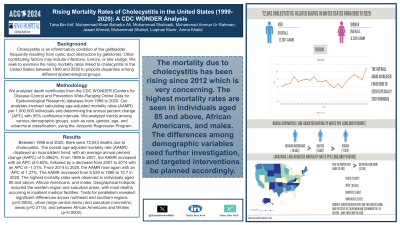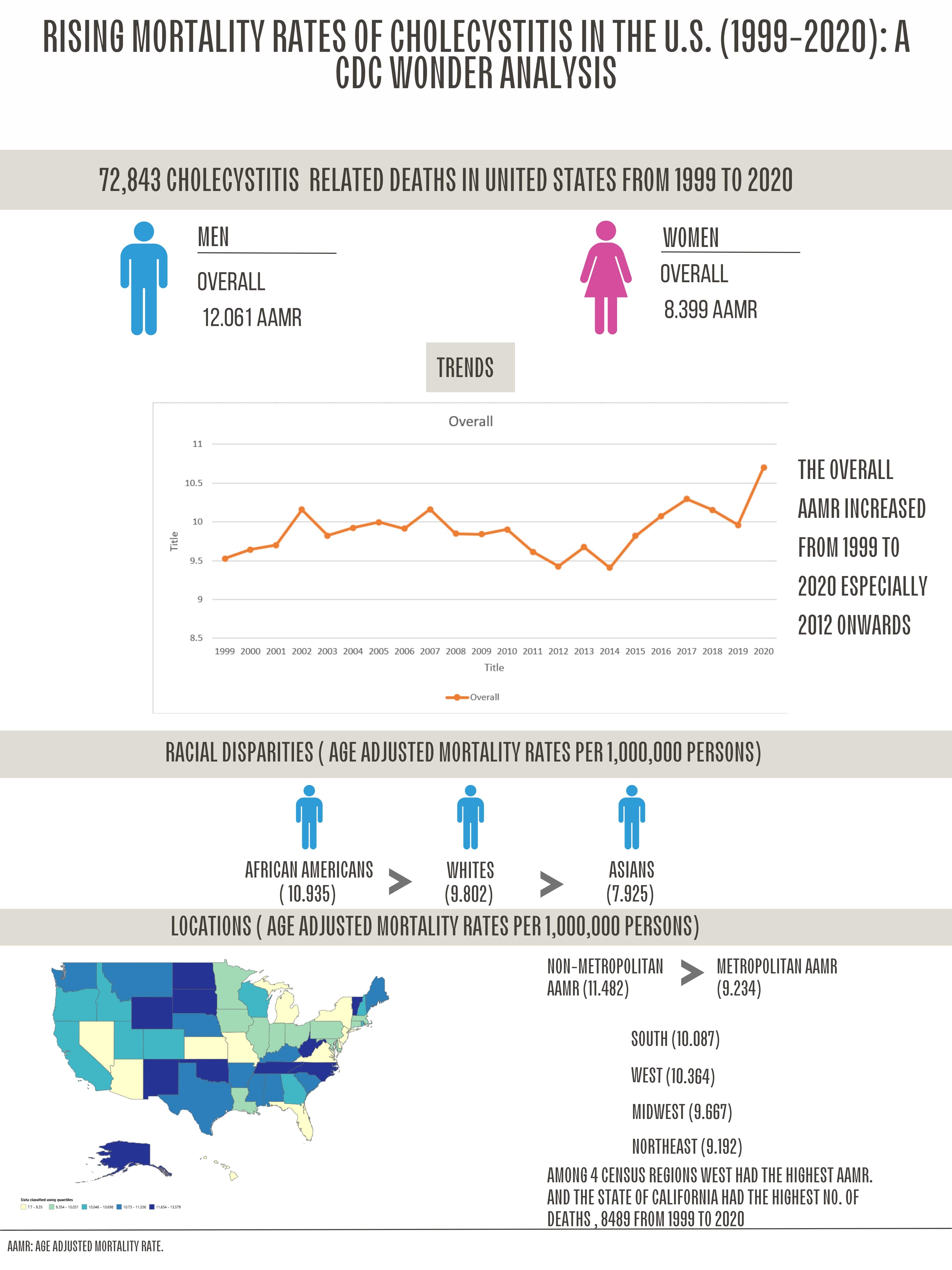Sunday Poster Session
Category: Biliary/Pancreas
P0031 - Rising Mortality Rates of Cholecystitis in the United States (1999-2020): A CDC WONDER Analysis
Sunday, October 27, 2024
3:30 PM - 7:00 PM ET
Location: Exhibit Hall E

Has Audio

Taha Bin Arif, MBBS, MD
Sinai Hospital
Baltimore, MD
Presenting Author(s)
Taha Bin Arif, MBBS, MD1, Muhammad Khan Bahadur Ali, MBBS2, Muhammad Shahzaib, MBBS2, Muhammad Ammar Ur Rahman, MBBS2, Jawad Ahmed, MBBS2, Muhammad Shahzil, MD3, Luqman Munir, MBBS2, Amna Khalid, MBBS2
1Sinai Hospital, Baltimore, MD; 2King Edward Medical University, Lahore, Punjab, Pakistan; 3Penn State Health Milton S. Hershey Medical Center, Hershey, PA
Introduction: Cholecystitis is an inflammatory condition of the gallbladder, frequently resulting from cystic duct obstruction by gallstones. Other contributing factors may include infections, tumors, or bile sludge. We seek to examine the rising mortality rates linked to cholecystitis in the United States between 1999 and 2020 to pinpoint disparities among different epidemiological groups.
Methods: We analyzed death certificates from the CDC WONDER (Centers for Disease Control and Prevention Wide-Ranging Online Data for Epidemiological Research) database from 1999 to 2020. Our analyses involved calculating age-adjusted mortality rates (AAMR) per 1,000,000 individuals and determining the annual percent change (APC) with 95% confidence intervals. We analyzed trends among various demographic groups, such as race, gender, age, and urban/rural classification, using the Joinpoint Regression Program.
Results: Between 1999 and 2020, there were 72,843 deaths due to cholecystitis. The overall age-adjusted mortality rate (AAMR) displayed an inconsistent trend, with an average annual percent change (AAPC) of 0.3962%. From 1999 to 2007, the AAMR increased with an APC of 0.60%, followed by a decrease from 2007 to 2014 with an APC of -1.31%. From 2014 to 2020, the AAMR rose again with an APC of 1.27%. The AAMR increased from 9.529 in 1999 to 10.7 in 2020. The highest mortality rates were observed in individuals aged 85 and above, African Americans, and males. Geographical hotspots included the western region and suburban areas, with most deaths occurring in inpatient medical facilities. Tests for parallelism revealed significant differences across northeast and southern regions (p=0.0004), urban (large central metro) and suburban (nonmetro) areas (p=0.0115), and between African Americans and Whites (p=0.0002).
Discussion: Cholecystitis typically presents as severe right upper abdominal pain, fever, nausea, and vomiting, significantly impairing a patient's quality of life. If left untreated, cholecystitis can lead to serious complications such as gallbladder rupture or systemic infection, underscoring the importance of prompt medical intervention. The mortality due to the cholecystitis has been rising since 2012 which is very concerning. Moreover, the differences among demographic variables need further investigation, and targeted interventions be planned accordingly.

Disclosures:
Taha Bin Arif, MBBS, MD1, Muhammad Khan Bahadur Ali, MBBS2, Muhammad Shahzaib, MBBS2, Muhammad Ammar Ur Rahman, MBBS2, Jawad Ahmed, MBBS2, Muhammad Shahzil, MD3, Luqman Munir, MBBS2, Amna Khalid, MBBS2. P0031 - Rising Mortality Rates of Cholecystitis in the United States (1999-2020): A CDC WONDER Analysis, ACG 2024 Annual Scientific Meeting Abstracts. Philadelphia, PA: American College of Gastroenterology.
1Sinai Hospital, Baltimore, MD; 2King Edward Medical University, Lahore, Punjab, Pakistan; 3Penn State Health Milton S. Hershey Medical Center, Hershey, PA
Introduction: Cholecystitis is an inflammatory condition of the gallbladder, frequently resulting from cystic duct obstruction by gallstones. Other contributing factors may include infections, tumors, or bile sludge. We seek to examine the rising mortality rates linked to cholecystitis in the United States between 1999 and 2020 to pinpoint disparities among different epidemiological groups.
Methods: We analyzed death certificates from the CDC WONDER (Centers for Disease Control and Prevention Wide-Ranging Online Data for Epidemiological Research) database from 1999 to 2020. Our analyses involved calculating age-adjusted mortality rates (AAMR) per 1,000,000 individuals and determining the annual percent change (APC) with 95% confidence intervals. We analyzed trends among various demographic groups, such as race, gender, age, and urban/rural classification, using the Joinpoint Regression Program.
Results: Between 1999 and 2020, there were 72,843 deaths due to cholecystitis. The overall age-adjusted mortality rate (AAMR) displayed an inconsistent trend, with an average annual percent change (AAPC) of 0.3962%. From 1999 to 2007, the AAMR increased with an APC of 0.60%, followed by a decrease from 2007 to 2014 with an APC of -1.31%. From 2014 to 2020, the AAMR rose again with an APC of 1.27%. The AAMR increased from 9.529 in 1999 to 10.7 in 2020. The highest mortality rates were observed in individuals aged 85 and above, African Americans, and males. Geographical hotspots included the western region and suburban areas, with most deaths occurring in inpatient medical facilities. Tests for parallelism revealed significant differences across northeast and southern regions (p=0.0004), urban (large central metro) and suburban (nonmetro) areas (p=0.0115), and between African Americans and Whites (p=0.0002).
Discussion: Cholecystitis typically presents as severe right upper abdominal pain, fever, nausea, and vomiting, significantly impairing a patient's quality of life. If left untreated, cholecystitis can lead to serious complications such as gallbladder rupture or systemic infection, underscoring the importance of prompt medical intervention. The mortality due to the cholecystitis has been rising since 2012 which is very concerning. Moreover, the differences among demographic variables need further investigation, and targeted interventions be planned accordingly.

Figure: Figure 1: Graphical illustration of findings from the rising mortality rates of cholecystitis in the United States.
Disclosures:
Taha Bin Arif indicated no relevant financial relationships.
Muhammad Khan Bahadur Ali indicated no relevant financial relationships.
Muhammad Shahzaib indicated no relevant financial relationships.
Muhammad Ammar Ur Rahman indicated no relevant financial relationships.
Jawad Ahmed indicated no relevant financial relationships.
Muhammad Shahzil indicated no relevant financial relationships.
Luqman Munir indicated no relevant financial relationships.
Amna Khalid indicated no relevant financial relationships.
Taha Bin Arif, MBBS, MD1, Muhammad Khan Bahadur Ali, MBBS2, Muhammad Shahzaib, MBBS2, Muhammad Ammar Ur Rahman, MBBS2, Jawad Ahmed, MBBS2, Muhammad Shahzil, MD3, Luqman Munir, MBBS2, Amna Khalid, MBBS2. P0031 - Rising Mortality Rates of Cholecystitis in the United States (1999-2020): A CDC WONDER Analysis, ACG 2024 Annual Scientific Meeting Abstracts. Philadelphia, PA: American College of Gastroenterology.
